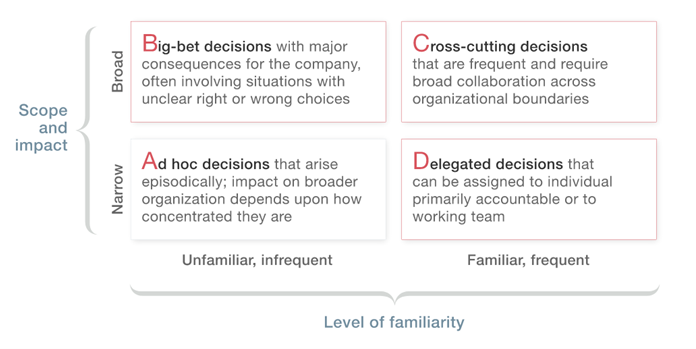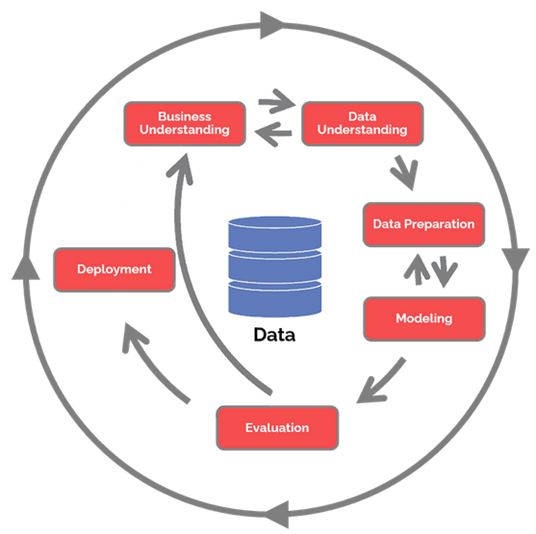The art of decision support.
An analytics project is constructed on the foundation of understanding the decisions users need to make. These decisions are data-driven and rely on information from fundamental systems or procedures. It is ideal for this data to be captured on a system; however, it often requires data detective work to find the information required. When approaching a new client or project, I prioritise the users’ decisions as the main drivers; however, in most projects I have worked on, it has taken time to identify the core decisions and the motivations behind them.
This post includes the following:
- Analytical projects differ in the type of managerial decisions they drive
- How to avoid scope creep and focus on the essentials for an analytical project
- The types of analytical projects you will encounter
- Some advice on analytical techniques and software
As analysts and data scientists, we can sometimes get caught up in the technology and methods that we use. The Fourth Industrial Revolution generates information and technology at an unprecedented rate, and it is challenging to keep up with. While this technology push is changing how we work daily, it will yield little value without a pull from users; therefore, I would like to re-emphasise the importance of understanding the end user’s decisions to design successful analytics projects.

The diverse types of managerial decisions
I begin by considering a framework of classic decision-making theory to understand the information a user requires. Decisions can be classified as strategic, tactical, or operational. Operational decisions are routine, and the processes surrounding them are well-understood and structured. Tactical decisions have slightly less certainty, but much of it is still understood and known. Here, the stakes can be higher, and some thought process is needed. Strategic decisions are primarily unstructured. In my experience, this tier of analytics is exploratory and ad-hoc.
McKinsey & Company has moved away from hierarchical thinking and believes that flatter and more agile companies are more productive—untangling decision-making. They classify decisions according to the familiarity and influence level, defining four major decision types: big-bet, cross-cutting, delegated, and ad-hoc (Figure 2).

Each decision, whether forward or backward-looking, requires a unique combination of methods and devices from technical and business stakeholders. Next, let us explore the diverse types of analytical projects that can be established in organisations.
The diverse types of analytical projects
The term ‘decision support systems’ (DSS) may have varied meanings for each individual. Several variations and specialities are present in the field. You might be familiar with most of them but allow me to clarify a few interlinking terms. Concepts often used with decision support systems include business intelligence (BI), analytics, data science, and artificial intelligence (AI).
- Business intelligence (BI) is a term encompassing databases, data manipulations, and the graphical display of data. The primary objective of a BI project is to present interactive access to data, which can be focused on analysts or business managers
- Analytics is the process of developing actionable business insights. The Institute for Operations Research and Management Science (INFORMS) defines analytics as combining the technology used with suitable management science techniques to solve problems. Analytics can be descriptive (historic or current situations), predictive (future conditions), or prescriptive (recommendation of best courses of action)
- Data science and analytics are often used interchangeably. Data science applies more to predictive and prescriptive analytics; it is the art of deriving feasible management science models (tested and validated). Data science projects emphasise a profound understanding of data science methods
- Artificial intelligence aims to replicate human thought processes by combining various technologies. These technologies enable AI to learn new skills, comprehend human language, and respond to inquiries
Along the analytics continuum—descriptive, predictive, and prescriptive—various skills and techniques are required. An analytics developer can be an expert on predictive modelling (i.e. using advanced machine learning models) but lacks database management skills. To provide decision support, it is essential to understand the project’s requirements and suitable data. This includes identifying whether users need to consider future events, such as a farmer observing the seven-day weather forecast to decide whether to cover a crop or whether they only need to know contextual figures, such as market positioning, to act in a general direction. Decision support involves identifying appropriate skills and data to meet the end user’s needs.
The scope creep rise and fall
Those who work in information services are well aware of how quickly a project concept can change. An initial investigation or request to direct a business need can transform into an entirely new product, often beyond the original project agreement.
Why does this happen?
Psychologists use Johari’s Window as a method to understand bias. It classifies awareness into two categories: what is known to self and what is known to others. The intersection of the unknown to self and the unknown to others is where analytical projects are born; however, a ‘relevance gap’ exists between what the analyst, scientist, or developer considers and what is needed. The analyst’s task is to uncover as much information as possible to minimise this unknown quadrant.
How can you overcome scope creep?
According to a study by Prost et al. (2012)[1], only 6.4% of the 518 decision-support systems analysed were designed to support decision-making, while the remaining 93.6% focused on data exploration and understanding. In my experience, this is a significant element to consider. Successful analytical applications assume that users have a general question but may not always know the details of what they require; therefore, it is essential to observe the results before directing better, more detailed questions.
The CRoss Industry Standard Process for Data Mining (CRISP-DM) provides a valuable framework. It allows for the initial business and data understanding. The first step is understanding the business question and available data sources, followed by data preparation and modelling. Modelling refers to the steps applied to data to reach conclusions. Model evaluation validates that the results are accurate and sufficient. Once this phase is complete, the project team can deploy the project or re-enter another stage of the CRISP-DM cycle. Project planning delivery, according to this model, keeps everyone engaged and patient with the exploratory nature of data analytics projects.

McCosh and Scott Morton (1978)[2], considered trailblazers of decision support theory, offer guidelines to help your project succeed. I believe that this is valuable advice, even though it was provided nearly half a century ago:
- The system should be initiated by the managers intending to use it
- The system should be revised periodically and amended or replaced if it no longer serves a purpose
- It should serve a specific purpose and justify the ongoing operating and maintenance costs
- Teams should build systems, including users and technical specialists.
When designing and scoping an analytical project, collaborate directly with the end user(s)– eliminate all stakeholders in the middle (project managers, middle managers, etc). Allow for data discovery to acquire a shared understanding of the problem. After the initial minimum viable product is clearly understood, the technical team can begin to productise the project.
A note about software for analytical success
There is no shortage of analytical software products available on the market. It is equally important to know which products to use to manipulate data for your purpose, as it is to know which techniques to use. The latter should motivate the former—not the other way around. Each analyst or data scientist will have their preferred devices and tricks.
As a business leader, it is crucial to focus on solving the problem rather than finding a suitable device. Your function is to know enough to determine if the results can be trusted. The world of data is highly technical, and excessive hours can be wasted on the technical aspects of data wrangling. While most good analysts enjoy experimenting with data and new devices, this should not detract from identifying the critical answers as quickly as possible and developing iteratively with business users. In effect, an equal balance of technology pulls and pushes catapults the project to success.
A few weeks ago, I attended a session on a technology I had not used before—ThoughtSpot . The presenter, a skilled executive in business intelligence, claimed that ThoughtSpot only productises insights in dashboards once a business question is routinely asked. All other insights, mostly ad-hoc, are answered through ThoughtSpot’s AI-powered analytics platform. I will now return to the process of decision support. To me, decision support is where business insights and technical ability converge. It involves identifying the core of a decision and supporting it with the appropriate data and techniques, regardless of technology. While technology is essential, finding the answer is what creates value.
If you want to discover more about decision support systems or viable solutions for your analytics projects, feel free to contact me. I enjoy exploring new projects with new and existing clients.
[1] Prost, S., & Dahanayake, A. (2012). Decision support systems: usage and applications in the field of business intelligence. Journal of Information Systems and Technology Management, 9(3), 459-474. SpringerLink
[2] McCosh, A.M. & Scott Morton, M.S. 1978. Management Decision Support Systems. 1st ed. Palgrave Macmillan London. DOI: https://doi.org/10.1007/978-1-349-02764-4.